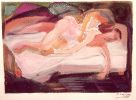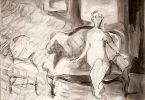Love and Intimacy (1981-1982): Drawings and Watercolours.
Although she has never expressed it in these terms, it can be said that Pilar Lara knew from the crucial moment of her return to the art world that, in the future, her work was going to have a ‘humanist’ and ‘existential’ aura, and that the most intimate and elemental aspects of human existence (love, fear, loneliness, frustration, violence, and always, death) were going to be the focus of her gaze, channeling her own restlessness and uncertainties. So, this was the step that genuinely and definitely made her become an artist: not meeting again the technique and ability to capture on a canvas the things she observed, but the discovery that art was a means of expression that emerged from inside the creator, and that took advantage of the real forms to shape a message. Besides, Pilar has always wanted that message to reach in a clear and straightforward way the people who gazed at her work. She wanted to share, communicate, not to shut herself away in codes and indecipherable ‘worlds of her own’. She also wanted to reflect the ‘real’ people’s desires, fears and obsessions in ‘real’ situations and everyday contexts, easily recognised by them, by herself, because in the zeal to socialise typical of her, she considered herself nobody special. A woman who, after coming home from the studio, had to take care of her children and her elderly family members, do the shopping to have something to eat in the fridge the day after…She did not act like an artist and did not consider herself to be different to other women of her generation who had sacrificed most of her individuality so that they could start a family and serve as an anonymous driving force of society. In any case, she always considered her ability to express herself through art as a gift, a privilege she had been granted, but should only be used to serve those who did not have the capacity to make themselves heard.
For this reason, Pilar Lara chose to make figurative art from that moment on, and thus deal with issues committed to humanity. Portraits, landscapes, safe themes and experiments with abstraction were left behind. Forever.
In this first phase (1981- 1982) of the ‘third stage’, she continues her technical investigations and experiments with drawing, watercolour, engraving and printing techniques. But now she is much more systematic and produces several series that explore variations on the same theme: almost without exception, romantic relationships between men and women and their erotic dimension. Actually, the choice of watercolour is no accident, because, as in the future, she will always be worried that the expressive content in the work is reinforced by the technical and material characteristics of the means chosen. Watercolour provides a great deal of sensuality to the romantic scenes of these works, but also, due to its lightness and speed of execution, reflects on the canvas a strong feeling of immediacy, and conveys the emotion of facing something momentary, fleeting, hard to grasp; and consistent with its diluted forms and blurred colours, reflects that moment of union in the highest point of love, as it can be seen in some of her drawings, where the lovers’ bodies are blending into each other.
These works are not only an exercise of artistic expression. They are also a cry for freedom, individual and collective, and for claiming female sexuality, not so much by her approach to the issue but by the fact of addressing that a woman could openly ‘talk’ about sexuality. Through them, Pilar fought the fear of one’s own pleasure instilled in several generations of women, and faced the negative and irrational influence of a repressive education. With them, she started to explore the freedom of a means not subject to any conventions. Therefore, it can be said that these works played an important role in her career that allowed her to get rid of a sort of burden; maybe for this reason, once she ‘sorted these things out’, they no longer interested her and she gradually abandoned the openly erotic compositions; or maybe because, despite connecting with typical phenomena of that social and historical context, such as women’s liberation, also in the most intimate aspects, she considered them relatively superficial.
She presented these works, together with the first engravings, in her first solo exhibition after her return to work, at the Orfila gallery (1982), with which she would be involved for a few years, including her appearance at ARCO- 95. And also, in the Primera Semana Española del Erotismo [1st Spanish Erotism Week] at the Centro Cultural de la Villa (1984).









